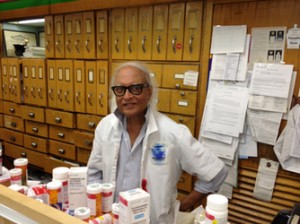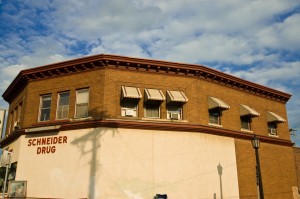by Gabriel Levitt, President, PharmacyChecker.com and Prescription Justice | Jan 31, 2014 | Advocacy, Drug Prices, Pharmaceutical Industry
Due to its lobbying efforts against drug importation reform to lower medication costs and funding of groups that mislead Americans about online pharmacies, scaring them away from safe and affordable medication sold outside the U.S., we often criticize Big Pharma on this blog. Speaking somewhat personally, I question myself sometimes whether they are deserving of such constant criticism. And then I read Daniel Hoffman from Philly.com in “Drug Prices: Higher and Higher” – and I’m reminded that they are!
Big Pharma is a on global government relations blitzkrieg to pressure countries into raising drug prices, spouting nonsense that the higher drug prices are supported by lower health care costs overall. Dr. Hoffman writes about pharma’s efforts in Germany to end a practice that enables doctors and other healthcare professionals to determine if new medications are truly an advance over old ones and merit higher drug prices. If they don’t then the government insurance plans will not reimburse for those products at a higher rate than older, proven medications. Seems fair!
Dr. Hoffman writes that India, with an incredibly dynamic pharmaceutical manufacturing industry, fights back against what that country views as overly aggressive intellectual property claims by Western drug companies. Sometimes India even views those patents as a threat to public health, and when it does it issues a “compulsory license” – the right to manufacture a generic even though there’s a patent in place.
I contend that this tactic can be abused by governments pressured by their own pharmaceutical industries – such as India. However, sometimes they are needed to save lives. What made me sick was a comment made by the CEO of Bayer, Marijib Dekkers, about India’s issuing a compulsory license for the drug Nexavar, which treats late stage kidney cancer. I’d prefer to quote a long section from Hoffman’s piece:
“We did not develop this medicine (Nexavar) for Indians,” Marijn Dekkers declared with unconcealed disdain. “We developed it for western patients who can afford it.”
A spokesperson for Doctors Without Borders later claimed that Dekkers represents ” ‘everything that is wrong’ with the multinational pharmaceutical industry.” (See here.)
That may be one way of looking at it. The other is that Dekkers is just more candid in admitting that pharma is all about making money and if millions of people have to die as a result, that’s just the way it is.
So are we being too hard on Big Pharma? The answer is no.
Tagged with: Bayer, Daniel Hoffman, Nexavar
by Gabriel Levitt, President, PharmacyChecker.com and Prescription Justice | Jan 23, 2014 | Drug Prices, Saving Money on Prescription Drugs

Tom Sengupta, pharmacist at Schneider Drug
A recent story on PBS made it pretty clear to me that you ought to check out your local mom and pop pharmacy before going to a big chain drugstore or an online pharmacy. Not only might you find better drug prices, but you could also be supporting the business of someone who really cares about you. I’m talking about people like Tom Sengupta, a pharmacist at Schneider Drug in Minnesota, who puts patients before maximizing profits, unlike some of the big pharmacy corporations.
Carol Thompson used to pay over $400 for a brand name drug, but once it went generic the price plummeted to $10 at her local Costco. That’s what we’ve come to except and need from our generic medication: much lower prices. Curious about prices at other pharmacies, Ms. Thompson called around and found some other pharmacies were charging about $400!
Mr. Sengupta is not the kind of guy who would charge you $400 for a generic medication. He explains that big chain pharmacies often determine drug prices for generics by simply charging less than the brand name drug, rather than a small mark-up from the wholesale drug price of the generic, like Schneider Drug does. Sometimes their pricing can even depend on the circumstances of the individual buying. Mr. Sengupta says: “My pricing is based on the person I’m talking to. You know, because if they need something, this is my responsibility to provide that to them. I’m not losing any money.”

Schneider Drug
PBS reported that Schneider Drug charges $14 for 30 pills of Letrozole 2.5mg. We just placed a phone call to a “local” chain pharmacy and they quoted a price of $599 – over 4,000% higher! Outraged by the pricing policies of some big chain pharmacies, Mr. Sengupta stated: “How could you justify that? You know? If you had any morality – we don’t need to make money like that. We have to ask, what’s happening? Where is their moral compass?”
So next time you have to fill a script check out your local independent pharmacy’s price. And if you’re visiting the Twin Cities and need a prescription medication, pay a visit to Mr. Sengupta!
Tagged with: Letrozole, PBS, Schneider Drug, Tom Sengupta
by Gabriel Levitt, Vice President, PharmacyChecker.com and Sam Werbalowsky, Pharmacychecker.com | Jan 10, 2014 | Drug Importation, Drug Prices, Generic drugs
Americans are used to high drug prices — at least for brand-name medications, which are often five times more expensive in the U.S. than in other countries. Conversely, Americans are used to low-cost generics, which are often cheaper here than internationally. Unfortunately, the U.S. generic pharmaceutical market is out of whack! Generic drug prices have begun rapidly rising over the past few months…
And rapidly rising can mean a price increase of 6,000%, as reported by recent articles in the Huffington Post, Washington Times, and The People’s Pharmacy. Here’s an almost unbelievable fact: the brand-name drug is often much less expensive – if you shop at an international online pharmacy.
So, why such drastic increases? The People’s Pharmacy article attributes the increases to three factors. First, consolidation among generic manufacturers means less competition among drug makers; forty-four percent of all generic drug revenue goes to just three companies. Second, companies are discontinuing the manufacture of certain drugs leading to drug shortages. Finally, FDA enforcement actions have shut down certain manufacturers because of poor manufacturing practices. With reduced supply and competition, it’s no wonder that prices are increasing.
So if you’re finding your generic medication rising in price, how can you find it for less…much less? Try the brand! I’ve identified some generic drugs below that have significant savings when the brand is purchased from abroad.
Prices for Generic Medications
| Drug |
Cash Price* |
International Online Pharmacy Price (Brand) |
Potential Savings (generic) |
| Clomipramine—75 mg, 90 pills |
$985 |
$121.50+
(Anafranil) |
88% |
| Duloxetine – 60 mg, 100 pills |
$734 |
$100++
(Cymbalta) |
86% |
| Doxycycline Hyclate — 100 mg, 100 pills |
$617 |
$251.21
(Vibramycin) |
59% |
*Cash price from local pharmacy in New York City. International Online Pharmacy Prices from lowest price on PharmacyChecker.com
+ Price calculated from 100 pills
++Price calculated from 84 pills
Tagged with: Anafranil, Clomipramine, Cymbalta, Doxycycline, Duloxetine, Huffington Post, The New York Times, The People's Pharmacy, Vibramycin
by Gabriel Levitt, President, PharmacyChecker.com and Prescription Justice | Dec 19, 2013 | Advocacy, Drug Prices
Americans with cancer are two times as likely to go bankrupt than other Americans due to the expense of treatment, including astronomical prices for prescription drugs. As reported by ABC News the alternative to bankruptcy is sometimes death.
This blog’s focus is often on international online pharmacies as a lifeline for high drug prices in the U.S. When it comes to cancer medications, online pharmacies are not always a solution since many can only be administered in a clinical setting are not suitable for mail-order pharmacy. However, some cancer meds are suitable for mail order pharmacy, and can be found for much cheaper prices from an international online pharmacy as opposed to a U.S. pharmacy.
Bristol Myers Squibb’s product Sprycel, which treats leukemia, costs $11,000 (60 pills, 50 mg) at a CVS in New York City pharmacy. The same quantity is available from a PharmacyChecker.com approved pharmacy for $5,509, or 50% cheaper. That’s $60,000 savings a year, a discount higher than the median household income in the U.S., and for some the difference between life and death.
Tagged with: Bristol Myers Squibb
by Gabriel Levitt, Vice President, PharmacyChecker.com and Sam Werbalowsky, Pharmacychecker.com | Dec 12, 2013 | Drug Prices, Pharmaceutical Industry
I’d be pretty upset if the next time I went to the pharmacy to pick up my asthma medication, the pharmacist asked me for $150. Why? Because I usually only pay $15 for it. Unfortunately, Americans all around the country might actually be facing this problem. In parts of Arizona, the price of a medication to treat valley fever rose 1,000%. At some Costco stores, the price of one dosage of Irbesartan jumped to about nine times the price of other dosages.
One person’s lament about the price of Asacol HD jumping from $50 to $600 is shared on YouTube. Fortunately, he could afford the new price and had some extra medication he could take. Unfortunately, not everyone is so lucky.
To quote his video, the “only reason the companies will stop doing B.S. like this is if people stand up to it and say ‘That is not okay!’” Until that happens effectively, you can compare prices at local and online pharmacies to make sure you find the most affordable medication.
Tagged with: Asacol, Irbesartan
by Gabriel Levitt, President, PharmacyChecker.com and Prescription Justice | Dec 6, 2013 | Drug Prices, Healthcare Reform, Medicare Drug Plans
Your prescription drugs will never be free under Medicare Part D. The “closed” donut hole under Obamacare does not create a new coverage period under Part D during which your co-pays and co-insurance, not to mention deductibles and premiums, disappear. That’s not a reason to complain. We should shoulder costs for our healthcare, including medication, as long as they are affordable (after all, Obamacare is actually called the Affordable Care Act). So how does Obamacare strive to help you afford your prescription drugs if you’re on Medicare? First, a little history…
In the beginning, Medicare did not offer a prescription drug benefit and tens of millions of seniors paid for their medications entirely out-of-pocket. Let there be light: In 2003, Congress passed the Medicare Modernization Act, which was then signed into law by President Bush. That law gave birth to Part D – a prescription drug benefit available to Medicare enrollees. But there were holes! When Medicare Part D plans first launched in 2006, average monthly premiums were $25.93. After paying a standard deductible of $250, enrollees paid 25% of their drug costs until total drug costs (between the enrollee and insurer) reached $2,250. That’s $250 towards the deductible, $500 in cost-sharing, plus premiums of $311.16 for a total of $1,061.16 per year in out-of-pocket spending. That’s if you stayed out of the donut hole!
Enter the dark days of the “donut hole,” which, in 2006, meant 100% out-of-pocket spending between $2,250 and $5,100 – Ouch! Above $5,100 – an amount called, for good reason, “catastrophic costs” –enrollees only paid 5% of their drug costs. Part D maintained these basic components, except with rising costs in the form of higher premiums and deductibles, and a larger “donut hole,” until the passage of the Patient Protection and Affordable Care Act in 2010 – enter Obamacare (hope and change?).
(more…)
Tagged with: donut hole, Medicare Part D, Obamacare




